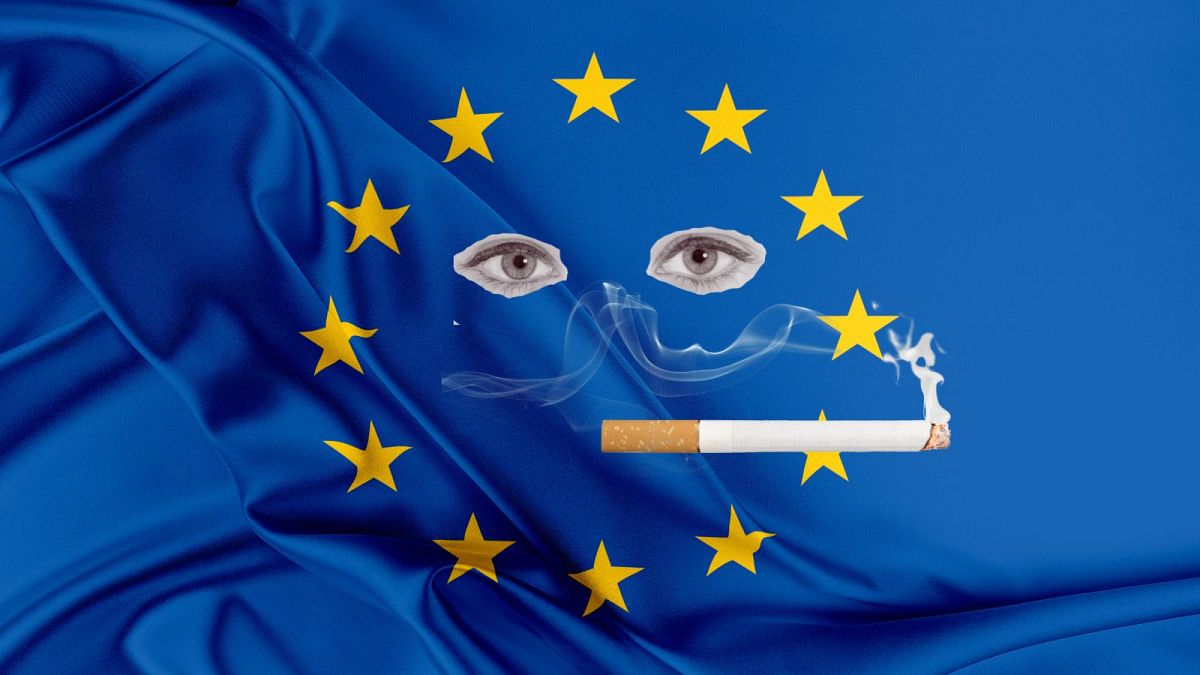The UK has announced further plans to deter smokers with new packaging. But how do European countries compare in terms of smoking and vaping rates?
Graphic images of lung disease, cancer warnings and plain packaging on cigarettes have become commonplace but the UK government is looking to go one step further and include inserts with messages of advice on how to stop smoking in packaging.
It's part of an ongoing crackdown on smoking in the UK, following the announcement in May of a clampdown on electronic cigarettes being sold or handed out to people aged under 18.
The UK Department of Health and Social Care (DHSC) announced the beginning of a consultation on the plans to include inserts for a range of products, including cigarettes and rolling tobacco.
The British government unveiled plans earlier this year to help smokers quit smoking tobacco by switching to e-cigarettes, but it calls the rise in youth vaping a cause for concern and says non-smokers should not be encouraged to start vaping.
The UK's new "swap to stop" initiative unveiled in April aims to wean a million smokers off tobacco and onto vaping. The government also plans to offer pregnant women up to £400 (€456) in vouchers as a financial incentive to stop smoking.
The moves, which campaigners have called steps in the right direction, are part of a wider strategy to get the country "smoke-free" by 2030, or getting smoking rates down to roughly 5 per cent.
UK authorities have also rolled out an "illicit vapes enforcement squad" in a bid to crack down on the illegal sales of vapes to under-18s in shops.
In Ireland, legislation banning the sale of e-cigarettes to minors is expected to be enacted in July.
What's the situation in other countries in Europe, and how do their smoking and vaping rates compare?
Smoking in Europe
According to data compiled by Eurostat, 19.7 per cent of the EU population smokes daily. In 2019, 5.9 per cent smoked 20 or more cigarettes on a daily basis, and 12.6 per cent smoked fewer than 20 units.
The countries that smoke the most in the EU are Bulgaria, with 28.2 per cent of the population consuming tobacco daily, then Turkey (27.3 per cent), Greece (27.2 per cent), Hungary (25.8 per cent) and Latvia (24.9 per cent).
The countries with the fewest smokers are Sweden (9.3 per cent), Iceland (11.2 per cent), Finland (12.5 per cent), Norway (12.9 per cent) and Luxembourg (13.5 per cent).
Sweden, the European country with the lowest rates of smoking, has battled with cigarettes for years. Smoking was banned in all bars and restaurants in early 2005. In 2019, the ban was further extended to include outdoor seating in bars and restaurants as well as public places.
In the EU, men are more likely to smoke than women
Around Europe, men are more likely than women to smoke; 22.3 per cent of men aged 15 years old and over are daily cigarette smokers, compared with 14.8 per cent of women.
The countries where men smoke the most are Bulgaria (37.6 per cent), Latvia (34.4 per cent) and Romania (30.6 per cent). Conversely, the countries where women smoke the most are Germany (18.6 per cent), Croatia (19.2 per cent) and Bulgaria (20.7 per cent).
In Romania, 30.6 per cent of men smoke versus 7.5 per cent of women; in Bulgaria, 37.6 per cent are men, while 20.7 per cent are women; and in Latvia, 34.4 per cent are men versus 12.1 per cent of women.
In some countries, the difference between the two genders is narrower or even reversed.
In Sweden, despite its bans, it has been harder for women to quit smoking; 6.8 per cent still do, compared with 5.9 per cent of men.
In Denmark, 11.7 per cent of men smoke and 11.8 per cent of women.
In Norway, the difference is also narrow; 11 per cent of men smoke and women are two points behind at 9.4 per cent.
Most daily smokers have been smoking for at least 10 years
Figures suggest that across the EU, the vast majority of daily smokers in 2019 (76.2 per cent) had been smoking for at least 10 years.
The statistics say 78.1 per cent of men who are daily smokers have smoked for at least 10 years, compared with 73.5 per cent for women.
E-cigarettes: Who vapes the most?
Electronic cigarettes are often promoted as safer than regular burning cigarettes.
But a recent comprehensive study by the BMJ medical journal says it is not possible to determine whether they are less harmful to the respiratory system than regular cigarettes.
The World Health Organization (WHO) says the so-called e-liquids used in e-cigarettes - whether they contain nicotine or not - typically comprise additives, flavours and chemicals that can be toxic to people’s health.
According to the latest data from Eurostat, the nations that vape the most among EU member states are France (6.6 per cent), Poland (6.0 per cent) and the Netherlands (5.9 per cent), occasional and daily vaping combined.
The lowest share of vaping is reported to be in Spain (1.0 per cent); Turkey reported a slightly smaller share at 0.9 per cent.
Among current vapers, those who vaped daily outnumbered occasional users in Poland, Ireland, Greece, France Portugal and Iceland.
In 20 member states, former vapers outnumbered current vapers. The seven where there were more current vapers than former ones were Latvia, Croatia, Lithuania, Greece, the Netherlands, Czechia and Ireland.
Tobacco smoking is the major preventable cause of cancer
The WHO estimates tobacco is one of the biggest public health threats in the world, killing more than eight million people a year.
Despite considerable progress made in recent years, the number of smokers in the EU is still high. The European Commission’s Directorate-General for Health and Food Safety says tobacco consumption is the “single largest avoidable health risk and the most significant cause of premature death in the EU”.
In Europe, 757,677 cancer cases are attributable to tobacco smoking and could be prevented, according to the international agency for Research on Cancer.
Around 50 per cent of smokers die prematurely, on average 14 years earlier.
It is interesting to note that Sweden, the country with the least amount of smokers in the bloc, is also the country with the lowest incidence of lung cancer.
Data from Finland, Luxembourg, and Portugal also shows a correlation with healthier lung cancer rates.
Eurostat is expected to publish its next report on figures on cigarette consumption in 2027.



